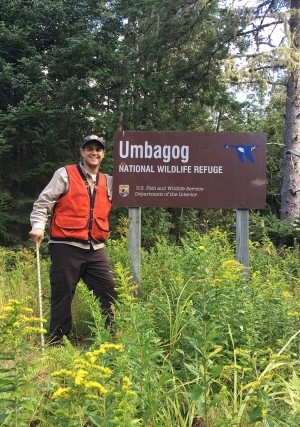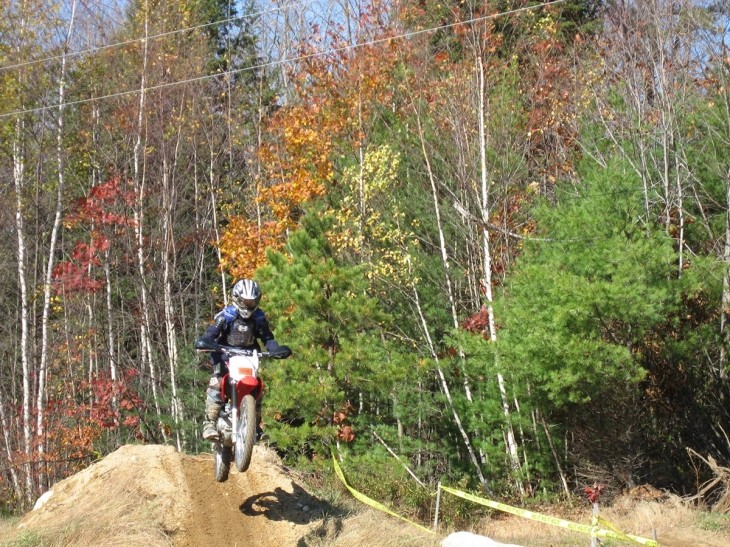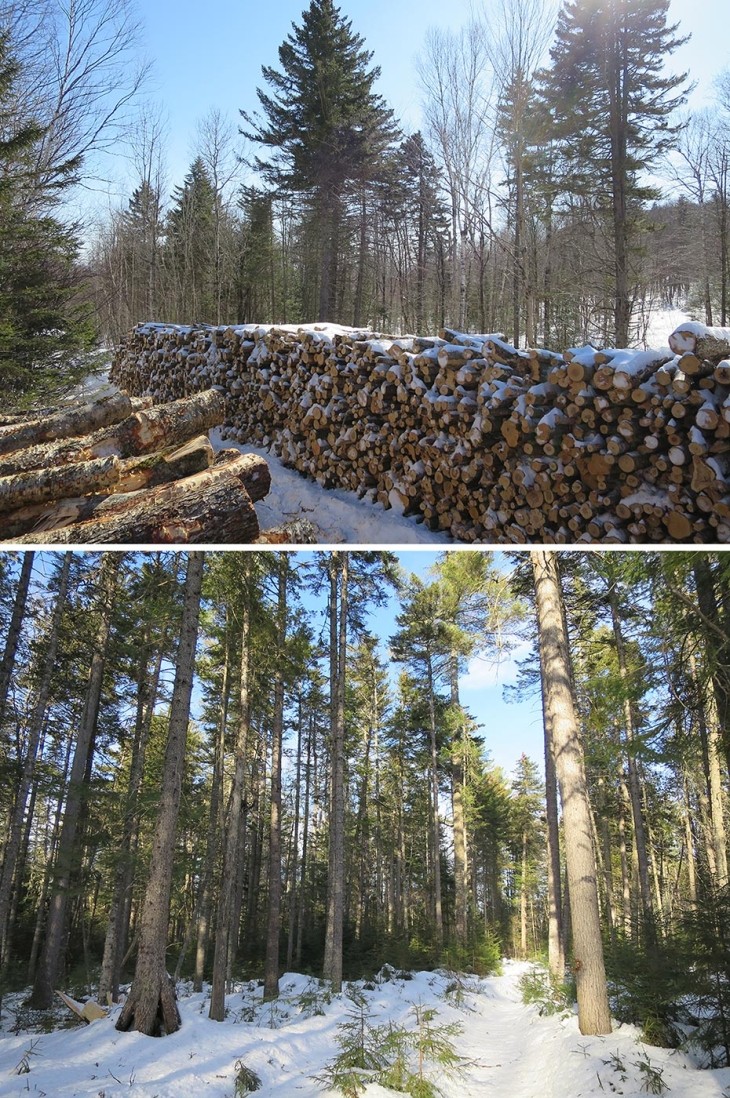Connor Breton grew up in Somersworth, New Hampshire, and became enamored of the woods at a young age. He attended the University of New Hampshire, where he studied environmental science, then earned a master’s degree in natural resources, with a focus on forestry. For the past two years, he’s worked as a forester for the U.S. Fish and Wildlife Service in the Umbagog National Wildlife Refuge in Errol. At age 26, he’s one of the younger folks working in the woods, and he’s eager to learn from the foresters and loggers who have honed a familiarity with the landscape over many years.
As a kid, I never thought about trying to understand the woods, I just enjoyed them. But as I got older, I became increasingly interested in understanding the natural world, and this desire for understanding has stuck with me. Since becoming a forester up north, I’ve become more familiar with northern hardwood and spruce-fir forests, which notably differ from the oak-pine and more central New England forest types I grew up around.
My favorite childhood activities – camping and riding dirt bikes – have also given me a sense of stewardship. When I was younger, I often saw trails being shut down due to misuse and illegal dumping. This demonstrated that irresponsible use has consequences, and those early experiences have led me to want to conserve forests so that others may find similar enjoyment and inspiration.
I was obsessed with wildlife and thought that I might become a zoologist, but by college I was more interested in climate change and broad-scale environmental issues. I pursued a B.S. in environmental science at the University of New Hampshire and worked in an eco-hydrology lab that primarily studied water use in trees and forests. As graduation approached, I realized that I was going to have to channel my environmental science degree into a more specific discipline – but I couldn’t. I had too much interest in too many disciplines – wildlife, climate, soils, hydrology, forest ecology. Then I realized that forestry was a way to tie everything together. A responsible forester has to consider what they’re doing within the context of all these other disciplines.
People often think I’m a park ranger or a conservation officer, but a forester has very different responsibilities. I sometimes simplify what I do by saying that I decide why, where, what, when, and how to cut. A better description is that I take landowner objectives – ranging from purely ecological to purely economic – and strive to meet those objectives through responsible forest management. A forester must understand the woods they’re working in and how different silvicultural techniques will change those woods. Considering how long it takes northern forests to mature, foresters must also think and plan on long time scales. Evidence of a forester’s decisions will often be present beyond their lifespan.
One of the biggest challenges I’ve had as a young forester is limited exposure to harvesting equipment and operations. Since my undergrad degree was in environmental science, I was less familiar with these things than someone with a traditional forestry degree. Since setting up harvests is a big part of my job, not knowing the full range of equipment capabilities was a major obstacle and something I had to quickly learn. For example, I had to figure out how big a boulder the forwarder could drive over and whether the feller buncher could cut Tree A without also cutting Tree B right next to it. With the help of my colleagues, especially refuge Forest Ecologist Tom LaPointe and refuge Biologist Sean Flint, I have learned and become much more confident.
Some of the loggers and woodsmen I work with have been doing their jobs since before I was born, so it’s important that I recognize and appreciate their experience. While it’s my job to oversee harvesting at Umbagog, it is crucial that I acknowledge what I don’t know, and that I know when to lead and when to follow. I have learned a great deal from the people I’ve worked with, and it is always my intention to leave them wanting to work with me again.
As a forester at a national wildlife refuge, I primarily strive to provide and improve habitat for wildlife, especially for species that are of federal interest or concern. In short, my job is to provide habitat for wildlife while also promoting diverse, healthy, and resilient forests for the American public. And all of this must be done in an economically sensible manner. I find the most satisfaction in working towards ecological objectives. But it’s extremely important to note that economic and ecological objectives are not mutually exclusive, and you can have and achieve both simultaneously. Foresters don’t necessarily have to pick one or the other.
If I do my job well and make enough of the right decisions, I could have a positive impact on thousands of acres of forest, the wildlife that resides there, and the people who use and appreciate that forest. Not every job allows you to have that kind of impact or allows you to see and measure the impact you’re having. My primary responsibilities at Umbagog include analyzing and reporting forest survey data, writing plans for forest management and harvesting operations, setting up timber harvests and overseeing harvesting operations, and sharing information with visitors about the refuge, the northern forest, and local wildlife. I also get to assist with biological projects such as duck banding and loon monitoring. Foresters don’t always get to do this kind of work, and this is one of my favorite parts about working at a wildlife refuge.
Working in the North Country has allowed me to work in the woods while also staying close to my family. And I’ve seen so much wildlife here. I’ve seen moose, bobcats, bald eagles, black bears, and other species that are significantly harder to come by where I grew up. I also appreciate how rural it is here, and I’ve enjoyed getting to know another part of my home state. And I’ve come to appreciate winter again. Not only is the landscape beautiful when coated in fresh snow, but winter is Umbagog’s typical harvest season and there are no insects!
I think the top three challenges facing northern forests right now are development, invasive species, and climate change. Unfortunately, I foresee all of these challenges continuing into the future and becoming more difficult to deal with. The northeastern U.S. has a lot of forested land, but it also has a lot of people, and that overlap means high demands on natural resources. Invasive species – insect, plant, or otherwise – can drastically alter forest ecosystems, can reduce ecosystem diversity, and can be extremely difficult to control. And our forests will certainly change with the climate, with more central and southern New England species likely moving north, and higher in elevation.
The best thing that the northern forest has going for it is how many people care about it – whether for recreation, wildlife viewing, the products and services the forest provides, or its intrinsic value. It’s important to note, too, that land conservation and forest harvesting are not mutually exclusive. Harvesting is a useful and efficient tool that can be used to reach conservation-based objectives.
I enjoy exploring new areas and finding spots that truly feel wild. I mostly enjoy the times when I look around and see no evidence of other humans passing through – no tracks, no litter, no signs of anything human-made. It’s neat to think about how many years may have passed since someone else has been there. Ironically, I also really enjoy visiting sites that I’ve worked on and have since been cut. It is incredibly satisfying to see the results of your labor, especially when things come out exactly as you had envisioned.
I’m so grateful for the people who have supported me on my path to becoming a forester, from my parents to my professors at UNH to my colleagues at Umbagog and sister refuges who work so hard for the northern forest, and who have shared their wisdom and know-how with me.






Discussion *